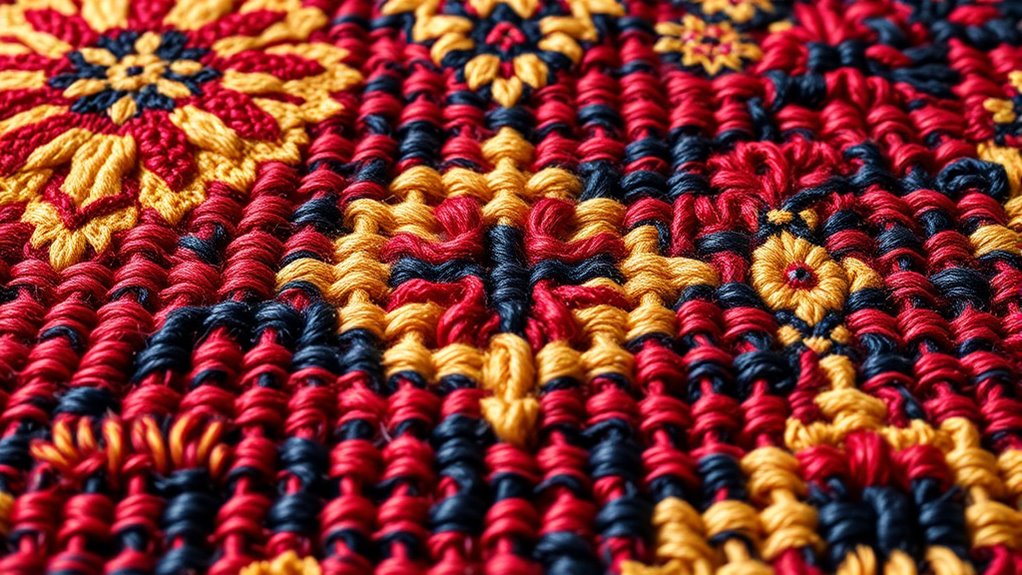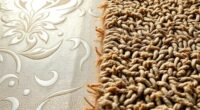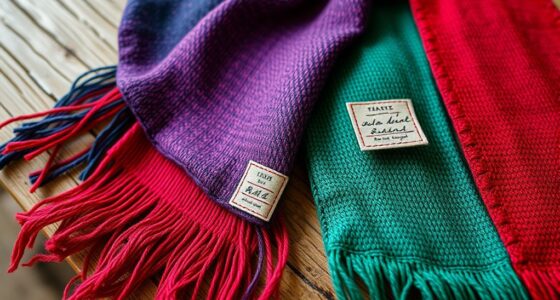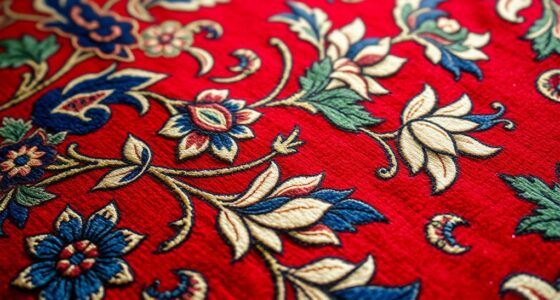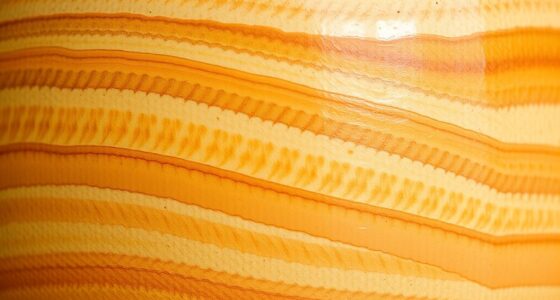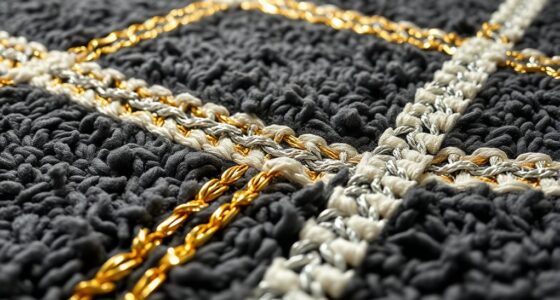To assess a $10K rug’s quality, look for high-quality materials like wool, silk, or organic dyes that resist fading. Examine the knot density and weaving for tight, precise craftsmanship. Check symmetry, pattern consistency, and finishing details like clean fringes and edges. Observe the dye depth and foundation strength. Authenticity is confirmed through provenance documents and certificates. Master these signals, and you’ll uncover the secrets to investing in a truly valuable piece.
Key Takeaways
- Examine the rug’s material quality, focusing on natural fibers and vibrant, high-quality dyes with excellent color fastness.
- Assess weaving craftsmanship by inspecting knot density, weave tightness, and neat fringe and border finishing.
- Check for symmetry, consistent pattern repetition, and precise alignment in design and edges.
- Confirm pattern continuity across the rug and uniformity in fringe length and border craftsmanship.
- Verify provenance with certificates and detailed documentation to ensure authenticity and proper origin.
Material Quality and Composition
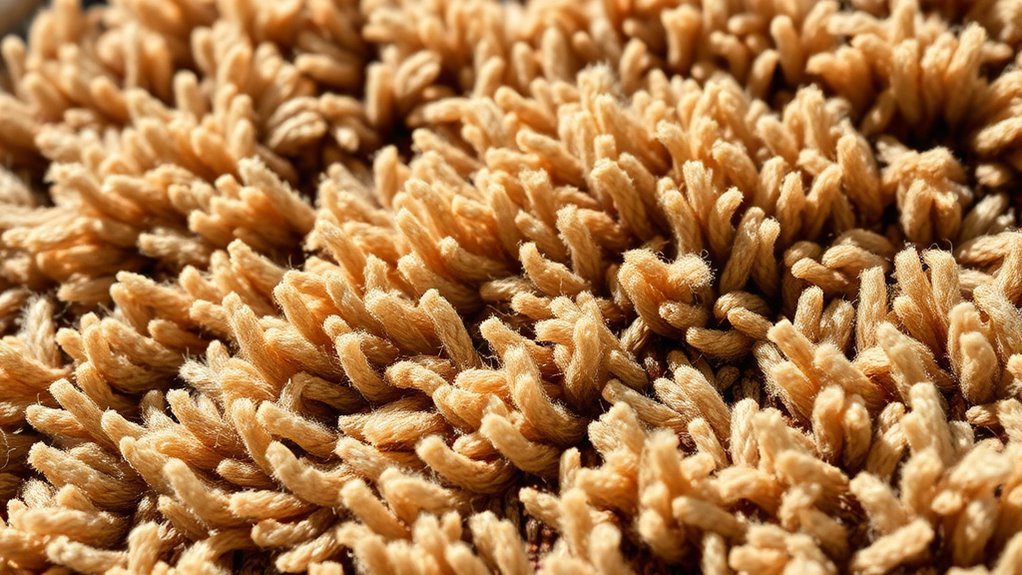
When evaluating rug quality, paying attention to the material quality and composition is essential, as these factors directly influence durability and appearance. High-quality rugs often use natural fibers like wool or silk, which offer longevity and a plush feel. If synthetic fibers are used, check for reputable brands that produce durable, well-made options. Additionally, consider the dyes applied; organic dyes tend to be more vibrant and eco-friendly, fading less over time. Synthetic dyes may be cheaper but can fade faster and sometimes stain. Understanding the composition helps you assess how well the rug will hold up in your space. Opt for rugs with natural fibers and organic dyes when possible, as they usually signify better craftsmanship and longer-lasting beauty. Material quality plays a crucial role in ensuring your rug maintains its appearance over the years. Incorporating exfoliation benefits from skincare insights can be analogous to choosing durable, well-made materials that ensure longevity and sustained beauty.
Knot Density and Weave Tightness
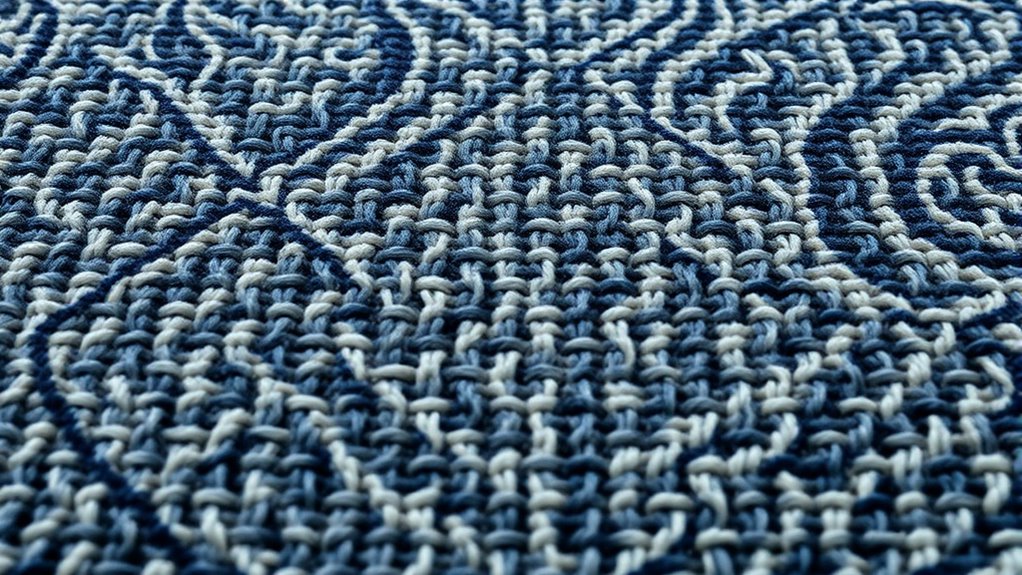
Knot density and weave tightness are essential indicators of a rug’s quality, as they directly impact durability and overall appearance. Higher knot counts mean a more detailed design and longer-lasting rug, while tight weaving prevents fraying and wear. Examining fringe craftsmanship reveals the precision of knot work, reflecting the skill involved. Additionally, a dense weave preserves dye vibrancy, ensuring colors stay vivid over time. Recognizing craftsmanship details like these can help buyers make informed decisions and select rugs that stand the test of time. Advances in automation technologies continue to influence how rugs are produced, often improving consistency and quality control. Use this table to compare:
| Rug Aspect | What to Look For | Why It Matters |
|---|---|---|
| Knot Density | More knots per square inch | Better detail and durability |
| Weave Tightness | Minimal gaps in the weave | Enhances longevity and appearance |
| Fringe Craftsmanship | Neatly finished, even fringes | Sign of skilled knot tying and quality |
A well-crafted rug balances knot density, tight weave, and fringe perfection, ensuring it remains beautiful for years. Recognizing quality signals like these can help buyers make informed decisions and select rugs that stand the test of time.
Craftsmanship and Finishing Details

Craftsmanship and finishing details are key indicators of a rug’s overall quality, reflecting the skill and care invested in its creation. Examine the weaving techniques; high-quality rugs often feature precise, even stitches that demonstrate expert craftsmanship. Pay attention to the edges and fringes—well-finished rugs will have neatly knotted or sewn borders, not loose or frayed ends. The dye stability is also essential; colors should remain vibrant over time without bleeding or fading, indicating the use of superior dyes and proper finishing processes. Look closely at the back of the rug—if the pattern is clearly visible and consistent, it’s a sign of meticulous craftsmanship. Additionally, inspecting the material quality can reveal much about the rug’s durability and longevity. High-grade materials, such as natural wool or silk, contribute significantly to the rug’s overall durability. Utilizing proper finishing techniques ensures that the rug maintains its appearance and structural integrity over time. Incorporating diversification strategies like high-quality rugs can also enhance the overall value and appeal of your interior design. Moreover, understanding the manufacturing process can provide deeper insights into the rug’s craftsmanship and authenticity.
Symmetry and Pattern Precision
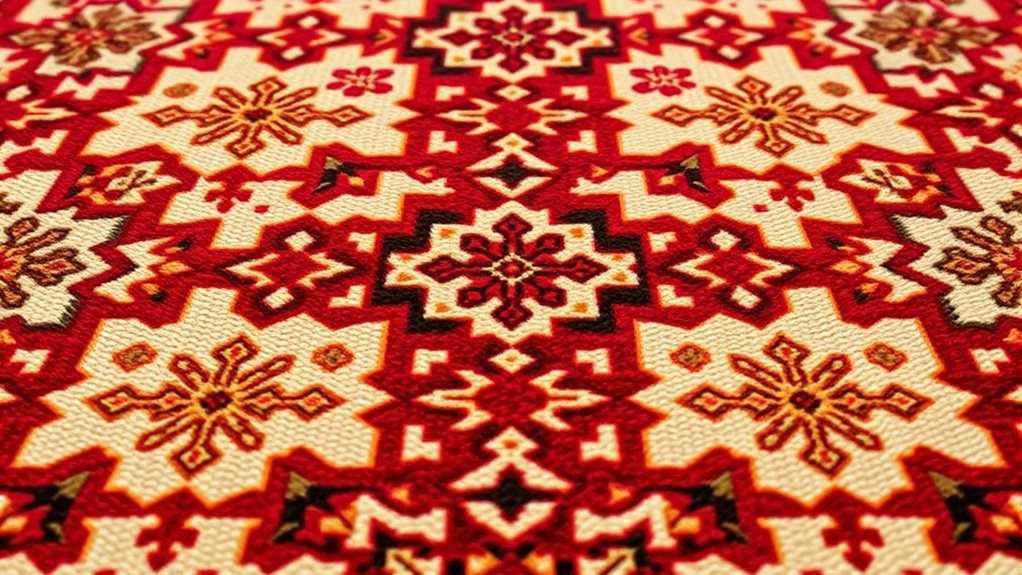
When inspecting a rug, look closely at symmetry alignment and pattern clarity to guarantee the design is even and well-defined. Check for consistent pattern repetition across the entire piece, which indicates careful craftsmanship. Also, examine the fringes and edges for precise finishing, as these details reveal the rug’s overall quality. Additionally, assessing the design integrity can help identify any inconsistencies or flaws that may affect the rug’s value and longevity. Paying attention to craftsmanship details can further ensure the rug’s authenticity and durability over time. In addition, understanding the vibrational energy associated with high-quality craftsmanship can give you a deeper insight into the value and energetic harmony of the piece. Recognizing sound recording techniques used in the creation process can also reflect the level of expertise involved in producing a high-quality rug. Moreover, awareness of regional craftsmanship styles can enhance your appreciation of the rug’s cultural significance and unique qualities.
Symmetry Alignment Clarity
Symmetry and pattern precision are essential indicators of a rug’s quality, as they reveal the skill and attention to detail involved in its creation. When examining a rug, look for symmetry in the fringe design, ensuring it’s evenly aligned and consistent on both sides. Border framing should be crisp and uniform, with no irregularities or distortions that suggest hurried craftsmanship. Clear symmetry alignment means you won’t see skewed patterns or warped lines, which can detract from the rug’s overall beauty and value. High-quality rugs maintain precise pattern alignment from edge to edge, reflecting careful weaving and meticulous craftsmanship. If the symmetry is off or the border framing appears uneven, it’s a sign that the rug may not have been crafted with the same level of expertise, affecting its longevity and visual appeal. Additionally, examining the craftsmanship involved can provide insights into the rug’s durability and overall worth.
Pattern Repetition Consistency
Consistent pattern repetition is a key sign of high-quality rugs, as it demonstrates precise planning and skilled weaving. When examining a rug, look for pattern consistency across the design. Well-made rugs feature symmetrical and evenly spaced motifs, with no irregularities or distortions. This pattern repetition reflects careful craftsmanship and attention to detail, ensuring the design flows seamlessly. If the pattern appears uneven or inconsistent, it may indicate rushed or subpar work. High-quality rugs maintain uniformity in their pattern repetition, even within complex designs. This level of precision shows the weaver’s expertise and the rug’s overall durability. Ultimately, strong pattern consistency confirms that the rug was crafted with care and skill, making it a worthwhile investment.
Fringe and Edge Precision
Fringe and edge precision are critical indicators of a rug’s craftsmanship, as they reveal the weaver’s attention to detail and skill. Well-executed fringe craftsmanship and proper edge finishing guarantee durability and aesthetic appeal. When inspecting a rug, look for these key signs:
- Uniform fringe length, indicating careful edge finishing.
- Tight, straight edges without fraying or unevenness.
- Symmetrical pattern alignment along the edges.
- Consistent weaving density across the border.
These details show the weaver’s dedication to precision and quality. Flawed edges or uneven fringes suggest rushed work or lower craftsmanship. High-quality rugs maintain symmetry and edge integrity, reflecting meticulous craftsmanship. Paying attention to fringe and edge details helps you identify a rug built to last.
Color Depth and Dye Quality
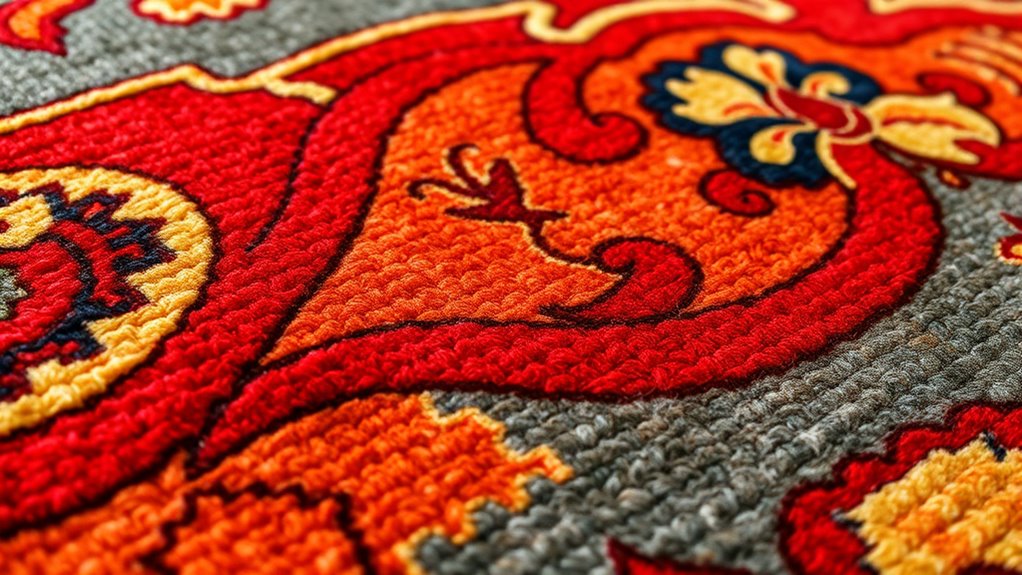
When evaluating the quality of a rug, color depth and dye quality are critical indicators of craftsmanship. Look for rich color saturation, which suggests the rug was dyed with high-quality pigments that remain vibrant over time. Good dye fastness is essential; it ensures the colors won’t fade or bleed when exposed to light, moisture, or cleaning. Examine the rug closely: deep, uniform colors indicate expert dyeing techniques. Avoid rugs with uneven patches or dull hues, as these often point to inferior dye processes. High-end rugs often use natural dyes, which develop richer, more complex tones, enhancing the overall appearance. Remember, superior dye quality not only boosts visual appeal but also guarantees your rug’s longevity and resistance to fading.
Backing and Foundation Strength

A rug’s backing and foundation are essential indicators of its durability and quality. Strong backing ensures the rug holds together over time, while a solid foundation maintains its shape and integrity. To evaluate this:
- Check the fringe craftsmanship—well-finished fringes indicate proper knotting and secure edge durability.
- Examine the edges—tight, even edges prevent unraveling and fraying.
- Feel the backing—firm and consistent backing suggests a sturdy foundation.
- Look for uniform knot density—dense knots contribute to overall strength and longevity.
A quality foundation supports the rug’s design and prevents premature wear, making your investment worthwhile. Remember, a well-constructed backing reflects craftsmanship and ensures your rug remains beautiful and durable for years to come.
Provenance and Authenticity Documentation
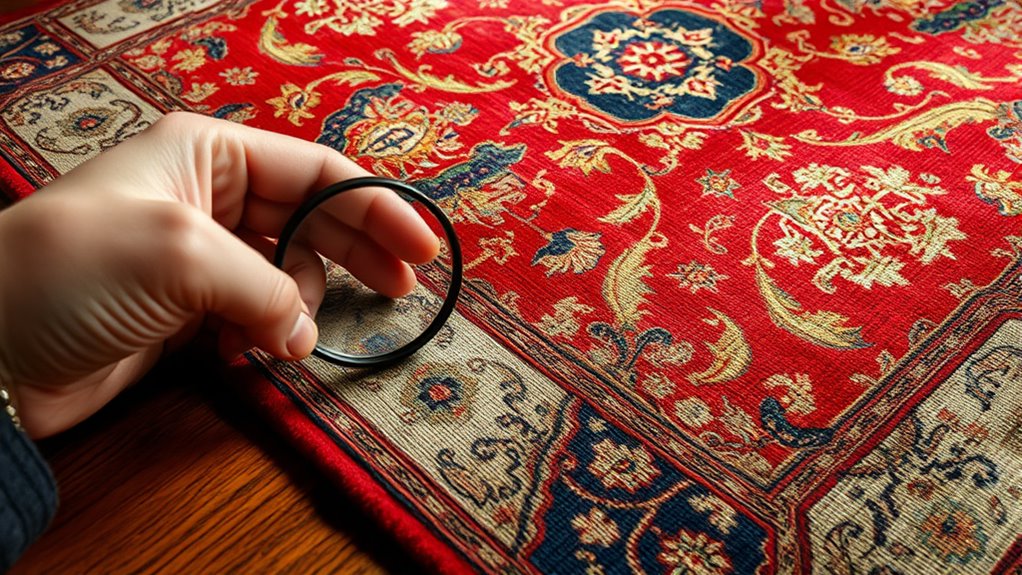
Verifying a rug’s provenance and authenticity documentation provides confidence in its origin and value. Authenticity verification involves examining certificates, receipts, and detailed provenance documentation that trace the rug’s history. These records confirm the rug’s origin, craftsmanship, and previous ownership, helping you avoid fakes or misrepresented pieces. When purchasing a high-end rug, always request provenance documentation from reputable sources. Well-documented provenance not only assures authenticity but also adds to the rug’s value and desirability. Be cautious of rugs lacking credible documentation, as they pose a higher risk of being counterfeit or heavily restored. Establishing clear provenance and verifying authenticity are essential steps to ensure your investment is genuine and worth the price.
Frequently Asked Questions
How Can I Verify a Rug’S Genuine Age and History?
They say, “History is written in the details.” To verify a rug’s genuine age and history, start with provenance documentation—ask for certificates or records from previous owners. Examine signs of antique restoration, like repairs or modern dyes, which can reveal its past. Consulting experts or appraisers can also help authenticate its age. These steps guarantee you’re investing wisely and truly understanding your rug’s story.
What Environmental Factors Can Affect a Rug’S Longevity?
Environmental impact and climate considerations play a vital role in a rug’s longevity. You should protect your rug from excessive humidity, which can cause mold and fiber deterioration, and avoid direct sunlight that fades colors. Extreme temperature fluctuations can weaken fibers over time. To guarantee your rug lasts, keep it in a stable environment with moderate humidity and proper climate control, reducing damage caused by environmental factors.
Are There Specific Signs of Poor Craftsmanship to Watch For?
While subtle craftsmanship flaws may seem minor, they can signal underlying weaving irregularities that affect a rug’s durability. Look for uneven knots, loose threads, or inconsistent patterns—these often point to poor craftsmanship. If you notice areas where the weave doesn’t align perfectly or threads seem frayed, it’s wise to contemplate these signs carefully, as they may impact the rug’s longevity and overall quality.
How Do Different Dye Types Impact Rug Durability?
Different dye types substantially impact your rug’s durability. Natural dyes tend to fade less and resist color bleeding over time, maintaining their vibrancy longer. Conversely, synthetic dyes may initially look bright but are more prone to dye fade and color bleeding, especially with exposure to sunlight or washing. Choosing high-quality dyes helps guarantee your rug stays beautiful and durable, protecting your investment for years to come.
What Maintenance Practices Help Preserve High-Quality Rugs?
Imagine your high-quality rug capturing every detail, waiting to impress. To keep it pristine, regularly vacuum using a gentle setting to avoid wool fiber damage. Rotate it periodically to prevent uneven wear, especially on high-traffic areas. Clean spills immediately with a damp cloth, and avoid harsh chemicals. With a high knot density, your rug’s intricate wool fibers stay intact longer, preserving its beauty and value over time.
Conclusion
Now, picture yourself walking onto a plush, intricately woven rug that feels as lush as a forest floor and radiates vibrant, lasting color. Every knot, pattern, and detail reflects craftsmanship you can trust. With these seven signals in mind, you’ll confidently spot a quality piece that’s worth every dollar. So, next time you’re eyeing that perfect rug, remember—you’re not just buying decor, you’re investing in a timeless work of art under your feet.
